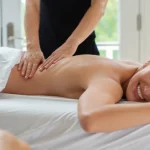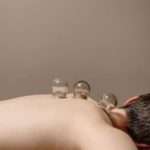Pregnancy is a time of incredible change—physically, mentally, and emotionally. While it brings excitement and joy, it can also bring discomfort, stress, and fatigue. That’s where prenatal massage comes in. Also known as pregnancy massage, this form of therapeutic touch is specifically designed to support expectant mothers. But if you’re considering a session, you might be wondering: Is it safe? When can I start? And what should I expect during a prenatal massage?
In this guide, we’ll explore the benefits of prenatal massage, important safety tips, when to schedule your first session, and exactly what happens during a treatment.
Table of Contents
🌸 What Is Prenatal Massage?
Prenatal massage is a type of therapeutic massage adapted to the needs of pregnant women. Unlike a traditional massage, it takes into account the physical and hormonal changes of pregnancy—especially weight distribution, joint strain, and sensitive areas.
Instead of lying face down, most expectant mothers are positioned side-lying with supportive pillows or bolsters to relieve pressure on the abdomen. Therapists also adjust their techniques, focusing on gentle strokes, light pressure, and safe areas of the body such as the back, hips, shoulders, legs, and feet.
Unlike a standard relaxation massage, a pregnancy massage is intended not just to soothe muscles, but also to support circulation, reduce stress, and improve overall comfort. The Cleveland Clinic notes that these adjustments make prenatal massage both safe and effective when carried out by a trained therapist.

💆 Benefits of Prenatal Massage
A growing body of research supports the many benefits of prenatal massage. From easing physical aches to improving mental wellbeing, here’s how it can help:
✅ Relieves Back, Hip, and Joint Pain
As your baby grows, your posture shifts, which often leads to backaches, hip strain, and joint pain. Prenatal massage uses gentle kneading and gliding techniques to relax tight muscles, especially in the lower back and hips, easing pressure on weight-bearing joints.
✅ Reduces Stress and Anxiety
Massage lowers cortisol (the stress hormone) and boosts serotonin and dopamine—your natural “feel-good” chemicals. According to the American Pregnancy Association, regular prenatal massage can reduce anxiety and even improve labor outcomes.
✅ Improves Circulation & Reduces Swelling
Fluid retention (edema) is common in pregnancy, particularly in the feet and ankles. Gentle, rhythmic strokes used in prenatal massage encourage better blood flow and lymphatic drainage, which may help reduce swelling.
✅ Supports Better Sleep
Poor sleep is a common complaint during pregnancy. By calming the nervous system and releasing muscle tension, prenatal massage can help you fall asleep faster and stay asleep longer.
✅ Encourages Emotional Wellbeing
The power of touch during pregnancy is profound. Prenatal massage can foster a sense of emotional connection, calm, and body positivity—all essential during this transformative time.
Beyond general relaxation, research suggests that prenatal massage can improve measurable health outcomes.
For instance, a study published in the Journal of Psychosomatic Obstetrics & Gynecology found that women who received bi-weekly prenatal massage for five weeks reported lower stress hormone levels (cortisol) and improved mood compared to a control group.
Another clinical observation from the American Pregnancy Association suggests that prenatal massage may even help reduce complications during labor by promoting relaxation and lowering maternal anxiety.
While more research is needed, these findings highlight that the benefits of prenatal massage are not just anecdotal—they have scientific support.
Is Prenatal Massage Safe?
One of the most common questions is: “Is prenatal massage safe?” The answer is generally yes—but there are important guidelines.
- Timing matters: Most providers recommend waiting until the second trimester. During the first trimester, miscarriage risk is highest, so many therapists avoid massage out of precaution.
- Positioning: Lying on your stomach is never advised, and lying flat on your back can restrict blood flow. Instead, therapists use a side-lying position with pillows or wedges for comfort.
- Pressure levels: Deep tissue techniques are avoided, particularly on the abdomen, lower back, and pressure points linked to uterine contractions. Gentle, moderate strokes are safest.
- Medical conditions: Women with preeclampsia, high blood pressure, blood clotting disorders, or placenta previa should consult their doctor before scheduling a session.
Verywell Health emphasizes that prenatal massage is safe when performed by a trained professional, but always best paired with medical approval if you have a high-risk pregnancy.
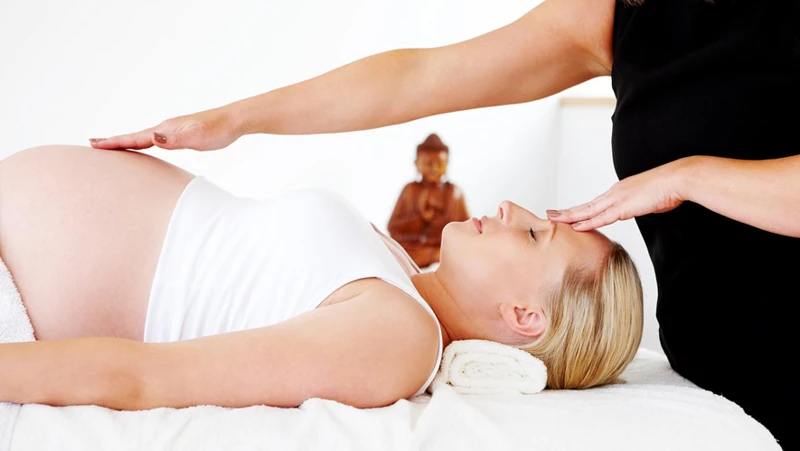
When Should You Start Prenatal Massage?
Most women begin prenatal massage in the second trimester (around week 14). At this stage, morning sickness usually eases, and the risks associated with early pregnancy decrease.
- Second trimester: Ideal for easing back and hip pain, reducing swelling, and improving energy.
- Third trimester: Sessions often focus on relaxation, circulation, and sleep support as the body prepares for labor.
How often? Many women schedule a massage every 2–4 weeks in the second trimester, increasing to weekly sessions in the third trimester if recommended by their healthcare provider. Healthline notes that this gradual increase helps mothers manage late-pregnancy discomfort more effectively.
What to Expect During a Prenatal Massage
If you’ve never had one before, here’s what happens in a pregnancy massage session:
- Consultation – Your therapist will ask about your trimester, medical history, and areas of discomfort.
- Positioning – You’ll lie on your side with special pillows and bolsters for support.
- Techniques – Therapists use gentle Swedish massage strokes to relax muscles, improve circulation, and ease joint pain.
- Focus areas – The back, hips, shoulders, legs, and feet are typically massaged. The abdomen is usually avoided.
- Comfort & Modesty – You’ll be covered with a blanket or sheet, with only the area being worked on exposed.
The overall experience is designed to feel soothing, nurturing, and restorative—a chance to connect with your body in comfort.
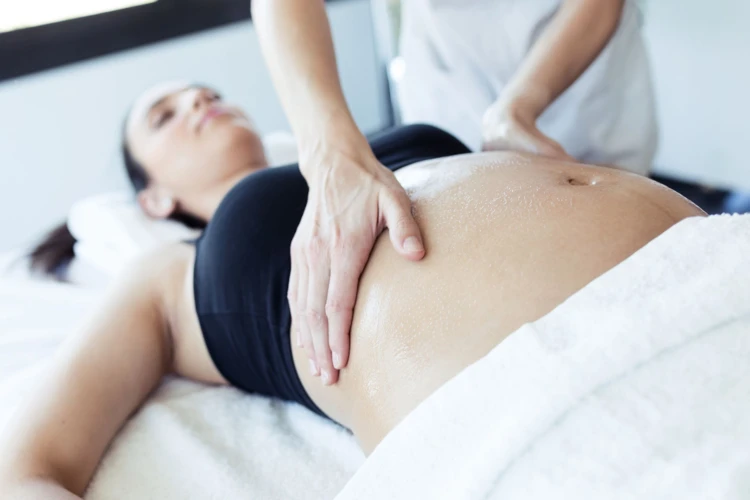
🌼 Prenatal Massage vs. Regular Massage
At first glance, a prenatal massage might look similar to a regular relaxation or Swedish massage, but there are important differences. Prenatal massage is specifically adapted to the needs of pregnancy, while a regular massage is not always safe for expectant mothers.
For example, a typical massage may involve lying flat on the stomach or back, both of which can cause discomfort and reduce blood circulation during pregnancy. Prenatal massage uses special bolsters, wedges, and pillows to ensure the client is comfortable and supported in a side-lying position.
Techniques also differ. In prenatal massage, therapists use gentler strokes and avoid deep pressure in areas that could stimulate uterine contractions or strain sensitive ligaments. A regular massage might focus on intense muscle release, but prenatal massage prioritises safety, circulation, and overall wellbeing.
The goals are also slightly different. While both types of massage can relieve stress and muscle tension, prenatal massage goes further by targeting pregnancy-related discomforts such as lower back pain, swollen ankles, and hip strain. This makes it a therapy that is not just relaxing, but also highly functional for the expectant mother’s unique needs.
🧑⚕️ How to Choose a Prenatal Massage Therapist
Not all massage therapists are trained in pregnancy care. When booking:
- Look for certification in prenatal massage or training in pregnancy-specific techniques.
- Ask about their experience with pregnant clients.
- Confirm they understand contraindications and safety measures.
- If unsure, request a referral from your OB/GYN or midwife.
This ensures your massage is both effective and safe.
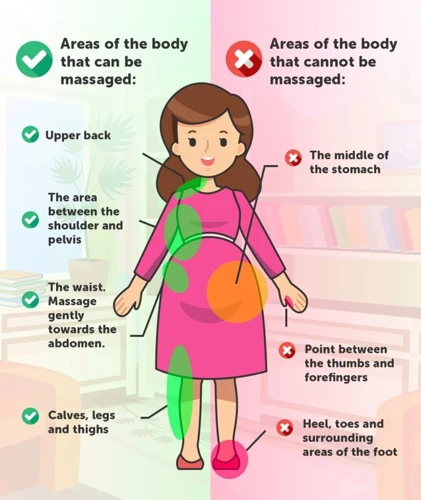
🌿 Tips for Getting the Most Out of Prenatal Massage
💧 Stay hydrated before and after (also see: Why Drink Water After a Massage?).
🗣️ Communicate with your therapist about pressure and comfort levels.
🕰️ Time your massage wisely—late afternoon or evening sessions may improve sleep.
🤸 Pair with light movement like prenatal yoga or gentle stretching for added benefits.
🚫 Risks and Contraindications
While prenatal massage is safe for most women, there are situations where it may not be recommended. Always consult with your healthcare provider before scheduling a session.
- 🍼 First trimester: Many therapists avoid massage in the first 12 weeks due to a higher risk of miscarriage during this period, even though there is no direct evidence linking massage to pregnancy loss.
- ⚡ High-risk pregnancies: Conditions such as preeclampsia, placenta previa, gestational hypertension, or preterm labor history may make massage unsafe.
- 💉 Blood clotting disorders: Pregnancy increases the risk of blood clots, and massage can potentially dislodge one in vulnerable women.
- 🤒 Infections or fever: Massage can worsen circulation of harmful pathogens.
- 🦵 Severe swelling or pain: This could indicate an underlying condition such as deep vein thrombosis (DVT), which requires immediate medical attention.
These precautions are not meant to discourage prenatal massage, but rather to highlight that it should be performed by a qualified therapist and with the guidance of a healthcare provider. Verywell Health stresses that when contraindications are ruled out, prenatal massage is generally safe and highly beneficial.
❓ FAQs About Prenatal Massage
❓ What are the benefits of prenatal massage?
Relief from back pain, reduced stress, improved circulation, better sleep, and enhanced emotional wellbeing.
❓ Is prenatal massage safe in the first trimester?
It’s typically avoided due to miscarriage risk. Most therapists recommend starting in the second trimester.
❓ When should you start pregnancy massage?
Around week 14, unless your doctor advises otherwise.
❓ How often should you get a prenatal massage?
Every 2–4 weeks in the second trimester; more frequently in the third if needed.
❓ What to expect during a pregnancy massage session?
Side-lying positioning, gentle techniques, focus on safe areas, and a comfortable, nurturing environment.
❓ Can prenatal massage help with labor preparation?
Some studies suggest it may help reduce anxiety and promote relaxation in the final weeks, but it’s not a substitute for medical care.
❓ Who should avoid prenatal massage?
Those with high-risk pregnancies, blood clotting disorders, preeclampsia, or other complications—always check with your healthcare provider.

🔗Related Articles
👉 How to Give a Relaxing and Comforting Back Massage to a Pregnant Woman
👉 Hot Oil Massage: How to Do at Home
👉 Fundal Massage: What You Need to Know
🌟 Conclusion
Prenatal massage is more than just a luxury—it’s a therapeutic tool for easing pregnancy discomforts, reducing stress, and improving overall wellbeing. When performed by a trained therapist and timed appropriately, it can be a safe and deeply rewarding experience for both mother and baby.
If you’re considering a pregnancy massage, talk with your healthcare provider and choose a certified therapist who understands the unique needs of pregnancy. With the right care, a prenatal massage can help you feel more comfortable, relaxed, and prepared for the journey ahead.
📚References
- Cleveland Clinic – Prenatal Massage: Benefits, Safety, What to Expect
- American Pregnancy Association – Prenatal Massage Benefits
- Healthline – Prenatal Massage: What You Need to Know
- Verywell Health – What Is a Pregnancy Massage?
⚠️ Disclaimer:
This article is for informational purposes only and does not constitute medical advice. Always consult with a licensed healthcare provider or certified massage therapist before beginning any new treatment, especially if you have pre-existing health conditions or concerns


